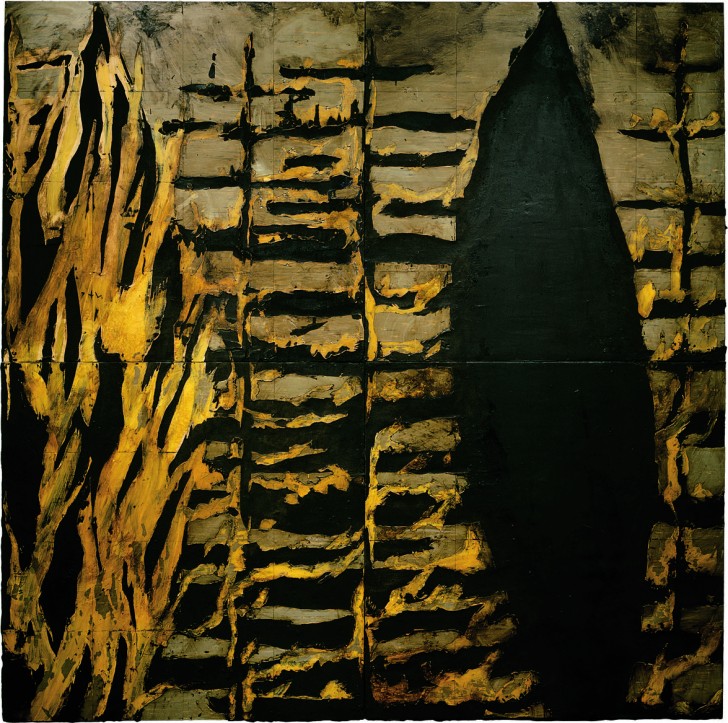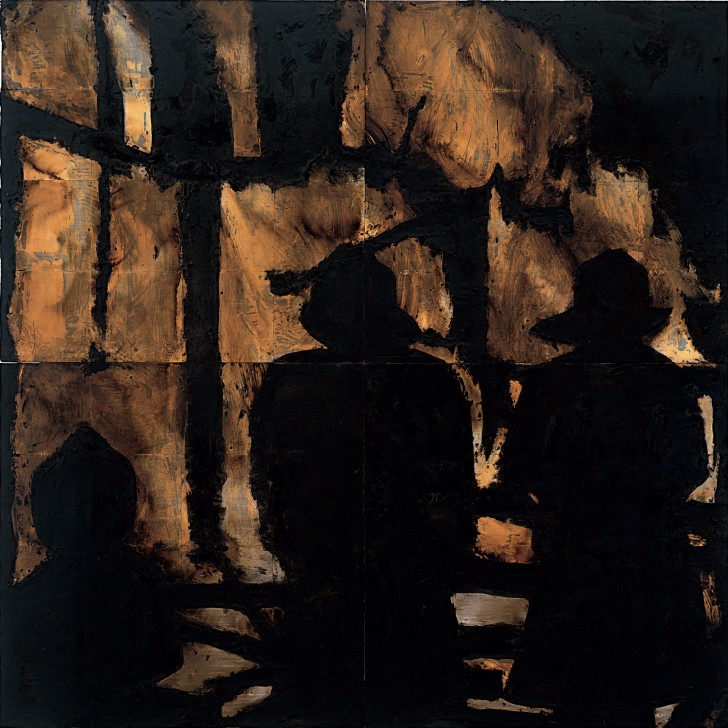How to process the persistent horror that earth is being consumed by an unstoppable, self-inflicted inferno? Coping mechanisms… irreverence, nihilism, denial? If none of these sit right with you—if you prefer to fill your lungs with smoke and rot, squint through pollution and shadow, and submit to tragedy rubbernecking—we have good news! New York based artist Donald Sultan spent the better part of the 1980s creating his 59-work series The Disaster Paintings, twelve of which are currently on display at the Smithsonian American Art Museum in Washington DC. Though The Disaster Paintings are most known for depicting bleak, industrial, post-war America, the exhibition takes viewers on a comprehensive tour of apocalyptic atmospheres, all of them man-made, and most fiery: environmental, urban, humanitarian, historical, at home, and abroad.

The Disaster Paintings are not strictly paintings, per se, but assemblages in the tradition of Robert Rauschenberg. They were created from industrial building materials—tar, Masonite, tiles, latex—the same ephemera that make up many of the works’ doomed structural subjects. As Sultan explained, his goal was to “make every aspect of the paintings an industrial creation.” He would first construct each piece from large Masonite slabs, mounting them with a square grid of linoleum tiles—the same cheap, pale blue, white-flecked flooring that paves the hallways of schools and hospitals. That underpinning tile grid provides a structural continuity to the series, with most of the works sharing a uniform eight-by-eight foot format. Against this grid, tar inlay, latex washes, and exposed tile render representative imagery and distinct figuration through interplay of negative and positive space. From there, the works were mounted on massive pallets, giving each piece a Stella-like gravity, asserting themselves as structural, sculptural art objects, not just hanging on but projecting from the walls.
Sultan’s choice of media is heavily invested with meaning, ranging from the highly personal experiences of a mechanic’s son and a young man who inhabited improvised bohemian New York City spaces, to the art-historical, in which he somewhat self-consciously positioned himself within the post-war creative moment. The industrial medium is indicative of Sultan’s artistic interest and background in Minimalism, Post Minimalism, Arte Povera, and Abstract Expressionism. Nonetheless, according to Sultan, the paintings themselves insisted on his inclusion of representational imagery and figuration, a leap for an artist who had formerly been faithful to abstraction. Over the course of the series, the representational images came into sharper focus as his technical skill in manipulating the materials progressed. Compare the simple, silhouetted cutout shapes in Forest Fire Jan 5 1984 to Venice Without Water June 12 1990, which marries Pollock-like layers of latex tears with crisp architectural rendering.
As Sultan’s dexterity with his materials improved, the changing chemical formulas of latex drove an expansion of color. The deep blackness of thick tar inlay is a constant throughout the collection, but the startling fluorescent orange and yellows of his early 80s works evolved into muddier, neutral earth tones, which ultimately evaporated into veils of blue and pale yellow. In addition to the chronological marker of color, the disasters depicted can be traced thematically throughout Sultan’s oeuvre. Forest fires become urban fires; factories choking the air with pollution become abandoned biohazards; an American catastrophe expands, encompassing Europe. Consider the simultaneous harmony and dissonance between material and subject in Fireman March 6 1985, in which orange latex flames illuminate and consume the scene of two firemen, starkly outlined figures created from absorptive black tar, imposed against imploding infrastructure. The deliberate use of construction materials to create scenes of structural collapse forces a discomforting cognitive dissonance, which Sultan describes as a “confrontation between stability and chaos… A building isn’t as fortified as we think it is.”

It is difficult to avoid projecting prophecy onto Fireman—undeniably, the scene now recalls ubiquitous imagery from the post-9/11 collective consciousness. Spookier still, a decade after he stopped painting disasters, Donald Sultan witnessed firsthand the ultimate American apocalyptic image. But Sultan was not painting prophecy, he was depicting inevitability, and constructing a series that “speak[s] to the impermanence of all things. The largest cities, the biggest structures, the most powerful empires—everything dies. Man is inherently self-destructive, and whatever is built will eventually be destroyed.”
Sultan sourced scenes for The Disasters from 1980s photojournalism, a feature that is almost transparent in the eye-catching, two-tone drama of the subjects; the precisely dated titles of each work; and the concise, informative compositions. This choice is a deliberate confrontation of the banality of news consumption—tragedy juxtaposed with advertisement, or dismissed as easily as the turn-of-the-page—a trope that has grown exponentially more pervasive in the Internet age. As painfully self-aware of our social media projections as we’ve become, so also have we become inured to news, with the proliferation of disaster porn resulting in a mass desensitization in our cultural psychology.
Despite the everyday nature of these ‘ordinary’ tragedies, The Disaster Paintings confront viewers with jarring immediacy by capturing the very moments during or following each disaster. The viewer is placed within the scene, a captive onlooker; a stand-in black-tar figure. In Accident July 15 1985, a train crash emerges out of negative space between shadows, smoke, and tar, with the tile grid mapping the jumbled wreckage onto a disjointed architecture. This work evokes the stunned moment before response, the surrealism of witness. Sultan said that the artworks he created were “not really about the crash but what follows.” Accordingly, Accident projects on-lookings into the moment between realization and implication, where lingering shock has begun to give way to discernment out the outcome.

The Disaster Paintings do not suppose the source of these catastrophes—the accusatory finger is pointed squarely at mankind and the hideous, modern civilization that he has built—a moral position that is most obviously claimed in Sultan’s industrial scenes. Take two works acting as before-and-after evidence in the grim investigation of progress and decay: Plant May 29 1985 and Dead Plant Nov 1 1988. In the former, a gray, polluted sky dimly illuminates the sinister shadows of a factory; tall, vertical shapes menace from the horizon, and the flat perspective creates an atmosphere that is so expansive as to feel claustrophobic. In the latter, crisp man-made structures fade into abstract dilapidation: the sinister glory of industry is gone, and the plant has been abandoned on the shoreline of a black body of water. Remarkably, if you search Sultan’s deeply industrial works for any sign that nature is reclaiming conquered ground following man’s self-eradicated, you’ll find none; strikingly, every scenes is cast with a depressing and bleak finality.
The pointed seriousness of The Disaster Paintings stands in firm opposition to the more stock postmodern motifs of satire, escapism, flippancy, and absurdism. Contrast The Disasters with other popular post-war works—Lichtenstein and Warhol; Vonnegut, Pynchon, and Heller. The central themes of consumption, war, and self-eradication haunt them all, yet the deployment of this spectre is distinctive as the contrast between high and low culture; profanity and propriety. Catastrophe, in The Disaster Paintings, is fully divorced from any glimmer of levity. Sultan’s apocalypse is humorless and unironic, a world of “atmospheres where you suddenly couldn’t breathe,” to say nothing of laugh.
When asked why, after decade of study and 59 artworks, he abandoned the disaster scenes for images of fruit and flowers, Sultan responded, “the world caught up to the paintings. Now every day there is a new catastrophe. So they don’t need me.” The timeliness of this collection’s tour is uncomfortably relevant: in 2017 America, the right to deny climate change is being as proudly defended as the promise of an industrial revival is being promoted through warmongering. Standing in front of these works, subjective dissociation from our cultural moment is nearly impossible, and you find yourself forced to dwell on our civilization’s ubiquitous, mounting vulnerability… this, you realize, is no trick of the light, no bad dream, no self-confirming cognitive bias; this, is the inevitability of the disaster.
